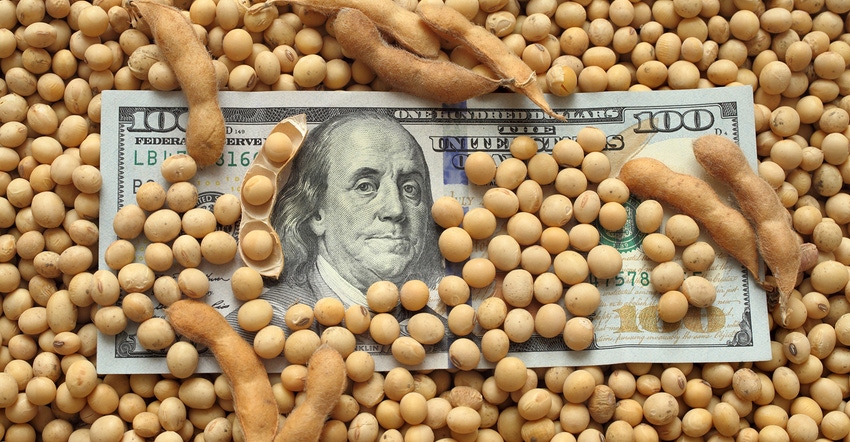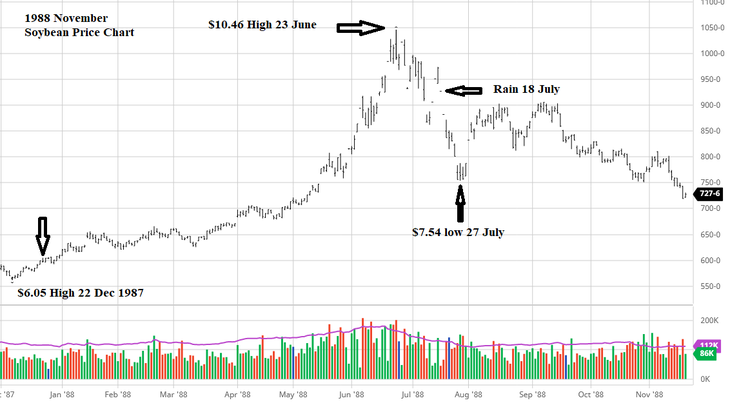
The two factors that determine your net cash price for grain are basis and futures.
I want you to be looking for the day of the year when:
Basis is most likely as firm as it will get for your delivery period.
The futures price is as close to the high for the year as one would reasonably expect.
Those two things will never occur on the same day. Why?
Most farmers are cash price sellers. They look at the cash price to decide when to deliver grain. If a farmer is looking for $13 soybeans, he or she is not looking at a specific futures price or a specific basis. When he can get $13 cash price, he will price his beans for delivery.
Merchandisers, on the other hand, are basis marketers. Making money on the basis change is a primary profit center for them, and it should be for you. Every penny a merchandiser makes on basis change is a penny a farmer could have had in his pocket.
Negative returns to storage
The basis for your grain will usually be firmest when the return to storage is a negative number -- a losing proposition. Farmers are the only people in the world who store grain and soybeans at a loss because they are cash price marketers.
When there is a negative return to storage, farmers need to set the basis for desired delivery period. That decision to set the delivery date by locking in the basis should have nothing to do with when you lock in the futures price.
Basis and futures are two different markets. One is a function of local supply and demand and the other is a function of world supply and demand. They peak on different dates every year and they bottom on different dates every year.
The futures price is out of everyone’s control, but basis is set by your merchandiser. Basis is the “throttle” merchandisers use to regulate the quantity of grain moving into their facility.
If the cash price is so low that farmers are not selling as much grain as a merchandiser needs, he or she will firm basis to increase the cash price high enough to attract more bushels. Three weeks ago, Cargill’s corn sweeter processing plant in Dayton, Ohio increased its cash price by $1.08 per bushel. The futures price was down 7 cents that week. Cargill firmed its basis for nearby delivery by $1.15 cents per bushel in one week! (Gosh, do you think they were really needing corn?) They shoved that “throttle” (basis) forward to increase the flow of corn into their facility.
You are thinking, “But, but, but… if I deliver my corn on a firm basis, which implies futures will be weak, how am I going to price my corn when the futures price is near the top?”
Each year is different. Some years, the firmest basis is long before the futures high is made and other years the futures high is long before the basis peaks. If you look only at cash price, you will miss both of those peaks.
A farm example
Arlen, a farmer in Kansas, called me last week and said his basis for fall delivery was 35 cents firmer than the basis for December delivery. He wanted me to confirm he was thinking correctly that the market was telling him to deliver corn at harvest and not store it. I told him that was exactly what his local market (basis market) was telling him.
Arlen will set the basis now for fall delivery. He will leave the future price open with the merchandiser. When he is finished delivering the corn, he will lock in December futures with his merchandiser, which will be coupled with his 15 cents over the December basis contract. That will determine his cash price with the merchandiser.
After fixing his cash corn price with his merchandiser, Arlen will then call his futures broker and buy the same number of bushels in the futures market. When corn futures price gets close to the top, Arlen will call his futures broker and sell his futures contracts.
If Arlen sells his futures contracts for a higher price than he bought futures, that profit will be added to his net cash sale of 15 cents over December. If Arlen sells futures at a loss, that loss will be subtracted from his net cash sale at 15 over the December futures. In either case, he greatly benefitted from what will most likely will be the firmest basis of the new crop marketing year.
On the other hand, if he puts the corn in the bin, he loses that 35 cents and he still gains or loses whatever the corn futures price does in the coming months and he would not have use of his money while the corn is in the bin.
Basis contract
If you do not have a futures account, you can accomplish practically the same thing with a basis contract at your elevator. Set the basis, deliver the corn, and the merchandiser will buy the futures for you and probably pay you a cash advance of 60% to 80% of the cash value of the corn. You can price the futures whenever you think you should.
Or, you can use a call option through your merchandiser (minimum price contract). Or you can buy a call option in your own options and futures trading account. With a call option, the risk of loss is limited to the cost of the call option, but the upside potential is unlimited.
Work at becoming a basis seller and a futures seller. They are two different markets and they usually move in opposite directions. If you quit being a cash price seller and become a basis and futures seller, you could easily add 10 to 20 cents per bushel each year, maybe more. It’s easy money and it costs nothing!

Wright is an Ohio-based grain marketing consultant. Contact him at (937) 605-1061 or [email protected]. Read more insights at www.wrightonthemarket.com.
No one associated with Wright on the Market is a cash grain broker nor a futures market broker. All information presented is researched and believed to be true and correct, but nothing is 100% in this business.
The opinions of the author are not necessarily those of Farm Futures or Farm Progress.
About the Author(s)
You May Also Like






